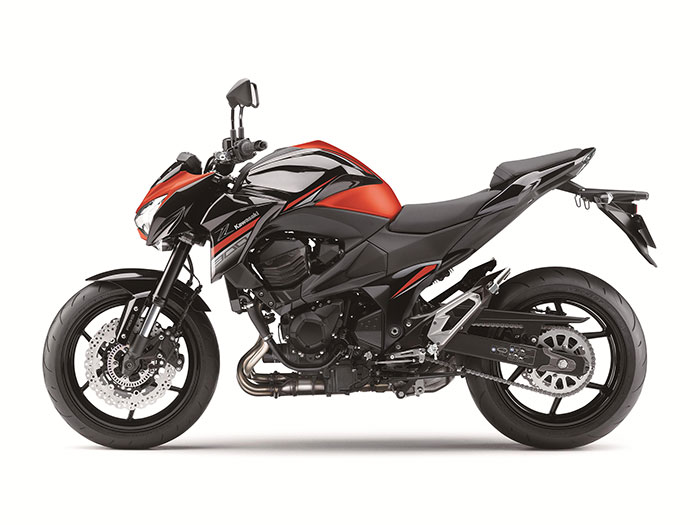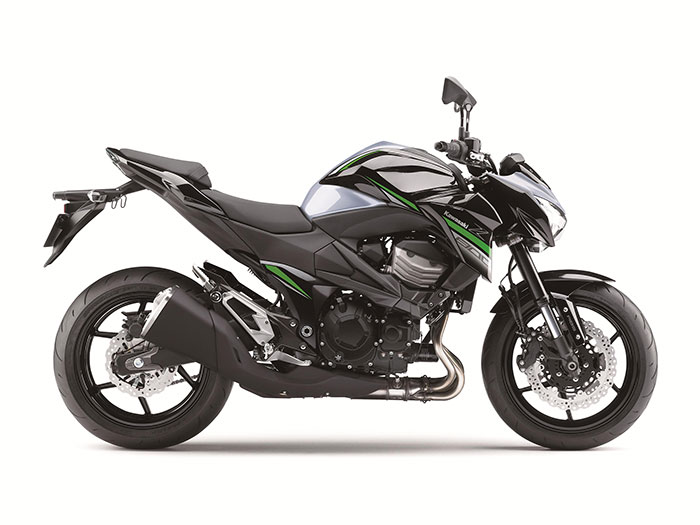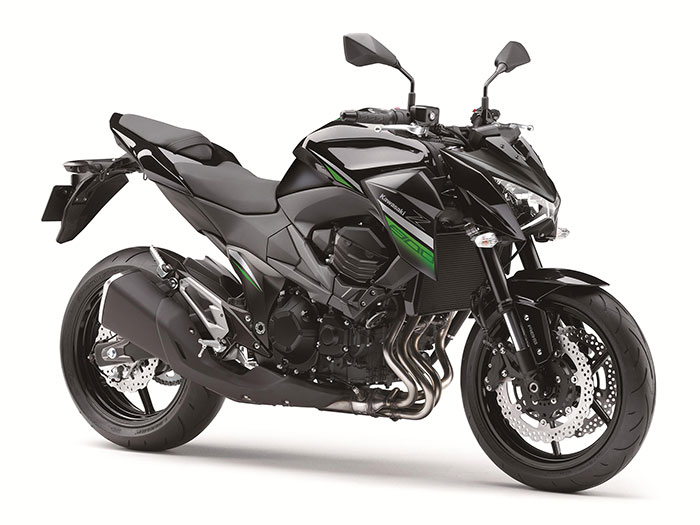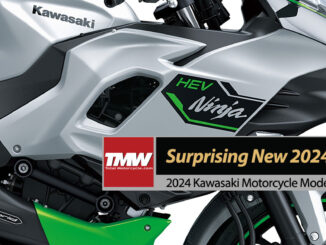
2016 Kawasaki Z800E ABS
2016 Kawasaki Z800E ABS Review
2016 Kawasaki Z800E ABS on www.Totalmotorcycle.com
The Undisputed Super Middleweight…
For those aspiring to their first machine in the middle weight super-naked category, there is now something truly outstanding on offer in terms of style and specification, the new Z800 e version. Available either as a 70kw machine or fully compliant with A2 licence regulation in its 35kw form, this is a motorcycle with style and panache plus a reassuring new engine and chassis package that delivers confidence, making the Z family as accessible as ever.
Available in ABS, ABS Performance, Non-ABS and Non-ABS Performance versions.
2016 Kawasaki Z800E ABS www.Totalmotorcycle.com Key Features
Optional ABS
ABS Models feature a compact and lightweight Nissin motorcycle ABS unit. The unit is located under the rider’s seat, contributing to increased room for storage under the passenger seat. Coulour Scheme shown of Z800
ABS
Sudden over-application of the brakes, or braking on low-grip surfaces (surfaces with a low coefficient of friction) such as wet asphalt or manhole covers may cause a motorcycle’s wheel(s) to lock up and slip. ABS was developed to prevent such incidents. Kawasaki ABS systems are controlled by high precision and highly reliable programming formulated based on thorough testing of numerous riding situations. By ensuring stable braking performance, they offer rider reassurance that contributes to greater riding enjoyment.
And to meet the special requirements of certain riders, specialised ABS systems are also available. For example, KIBS (Kawasaki Intelligent anti-lock Brake System) is a high-precision brake system designed specifically for supersport models, enabling sport riding to be enjoyed by a wider range of riders. And by linking the front and rear brakes, K-ACT (Kawasaki Advanced Coactive-braking Technology) ABS provides the confidence to enjoy touring on heavyweight models. Kawasaki is continually working on the development of other advanced ABS systems.
2016 Kawasaki Z800E ABS www.Totalmotorcycle.com Features and Benefits
Highly communicative chassis
While maintaining a highly sporty nature, the Z800’s friendly character makes it an accomodating mount even for beginners. Increased road holding performance, and hence traction, on all types of road surfaces enables both sporty and friendly riding characteristics. Tubular backbone chassis design with engine sub-frame and new connecting pipe, and revised chassis rigidity offer great feedback to the rider, communicating what the bike is doing in all situations.
806 cm3 liquid-cooled, 4-stroke In-line Four tuned for strong low-mid range torque
With its larger displacement, the Z800 engine offers increased performance at all RPM. The greater performance is especially noticeable in the low-mid range, adding greater everyday usability as well as increased riding exhilaration. Shorter final gearing complements the new engine character and emphasises the Z800’s stronger acceleration.
Enhanced braking performance
New opposed, 4-piston calipers (ABS version only) gripping larger-diameter 310 mm petal discs deliver formidable stopping power with superb control and feel. Colour scheme shown of Z800
41 mm inverted fork
41mm KYB Inverted fork contributes to the Z800’s quick, nimble handling, excellent road-holding ability and superb feedback. Optimized for the increased engine and revised frame rigidity. Colour Scheme shown of Z800
Natural riding position
The relationship between pegs, seata and handlebars was designed to enhance communication between rider and machine, giving the rider a confidence-inspiring feeling of control that perfectly complements its accurate and precise handling qualities. New seat design contributes to increased comfort for rider and passenger. Colour scheme shown of Z800
Full digital instrumentation
The Z800’s futuristic looking instrument panel features a triple LCD screen which includes a level-meter-style tachometer, fuel gauge, remaining range and the Economical Riding Indicator. Coulour Scheme shown of Z800
LED taillight
New taillight design features a “Z” pattern – a nice touch that complements the slim tail section of this latest Z-model. Coulour Scheme shown of Z800
Aggressive front cowl
Compact headlamp cowl uses a multi-facet design to create a more aggressive, glaring visage for the Z800. the fierce appearence is one of the key styling elements of the aggressive new design. Colour scheme shown of Z800
Sharp under-cowl
The under-cowl adds to the Z800’s street-fighter image and along with the engine shrouds contributes to the aggressive, visceral design. (optional) Colour scheme shown of Z800
Dual Throttle Valves
Late-model sport bikes often use large-bore throttle bodies to generate high levels of power. However, with large diameter throttles, when a rider suddenly opens the throttle, the unrestricted torque response is anything but gentle and often more than the rider can handle. Dual throttle valve technology was designed to tame engine response while contributing to performance.
On fuel-injected models, throttle bodies generally have only one throttle valve per cylinder. On models with dual throttle valves, there are two throttle valves per cylinder: in addition to the main valves, which are physically linked to the throttle grip and controlled by the rider, a second set of valves, opened and closed by the ECU, precisely regulates intake airflow to ensure a natural, linear response. With the air passing through the throttle bodies becoming smoother, combustion efficiency in improved and power is increased.
Like other Kawasaki engine management technology, Dual Throttle Valves were designed with the philosophy of “following the rider’s intention, while providing natural-feeling support.” They are featured on many Kawasaki models.
Economical Riding Indicator
Using high-precision electronic control for engine management, Kawasaki models can achieve a high level of fuel efficiency.
However, fuel consumption is greatly affected by throttle use, gear selection, and other elements under the rider’s control. The Economical Riding Indicator is a function that indicates when current riding conditions are consuming a low amount of fuel. The system continuously monitors fuel consumption, regardless of vehicle speed, engine speed, throttle position and other riding conditions. When fuel consumption is low for a given speed (i.e. fuel efficiency is high), an “ECO” mark appears on the instrument panel’s LCD screen. By riding so that the “ECO” mark remains on, fuel consumption can be reduced.
While effective vehicle speed and engine speed may vary by model, paying attention to conditions that cause the “ECO” mark to appear can help riders improve their fuel efficiency – a handy way to increase cruising range. Further, keeping fuel consumption low also helps minimise negative impact on the environment.
2016 Kawasaki Z800E ABS – www.Totalmotorcycle.com USA Specifications/Technical Details
US MSRP Price: $NA USD
NA
2016 Kawasaki Z800E ABS – www.Totalmotorcycle.com Canadian Specifications/Technical Details
Canada MSRP Price: $ See Dealer for pricing in CDN
NA
2016 Kawasaki Z800E ABS – www.Totalmotorcycle.com European Specifications/Technical Details
Europe/UK MSRP Price: £6,899 Non-ABS, £7,599 Non-ABS Performance Version, £7,299 ABS; £7,999 ABS Performance Version GBP (On The Road inc 20% Vat)
Engine
Engine type
Liquid-cooled, 4-stroke In-Line Four
Displacement
806 cm3
Bore x stroke
71.0 x 50.9 mm
Compression ratio
11.9:1
Valve/Induction system
DOHC, 16 valves
Fuel system
Fuel injection: ø34 mm x 4 (Mikuni), with dual throttle valves
Ignition
Digital
Starting
Electric
Lubrication
Forced lubrication, wet sump
Frame
Frame type
Tubular backbone (with engine sub-frame), high-tensile steel
Wheel travel, front
120 mm
Wheel travel, rear
137 mm
Tyre, front
120/70ZR17M/C (58W)
Tyre, rear
180/55ZR17M/C (73W)
Steering angle, left / right
31o / 31o
Performance
Maximum power
70.0 kW {95 PS} / 9,500 rpm
Limited power version
35 kW
Maximum torque
76.0 Nom {7.7 kgfom} / 8,000 rpm
Transmission
Transmission
6-speed, return
Final Drive
Sealed chain
Primary reduction ratio
1.714 (84/49)
Gear ratios: 1st
2.571 (36/14)
Gear ratios: 2nd
1.941 (33/17)
Gear ratios: 3rd
1.556 (28/18)
Gear ratios: 4th
1.333 (28/21)
Gear ratios: 5th
1.200 (24/20)
Gear ratios: 6th
1.095 (23/21)
Final reduction ratio
3.000 (45/15)
Clutch
Wet multi-disc, manual
Brakes
Brakes, front
Dual semi-floating 310 mm petal discs. Caliper: Dual twin-piston (non ABS) Caliper: Dual opposed 4-piston (ABS)
Brakes, rear
Single 250 mm petal disc. Caliper: Single-piston
Suspension
Suspension, front
41 mm inverted fork
Suspension, rear
Bottom-Link Uni-Trak, gas-charged shock. Spring preload: 7-way
Dimensions
Dimensions (L x W x H)
2,100 mm x 800 mm x 1,050 mm
Wheelbase
1,445 mm
Ground Clearance
150 mm
Fuel capacity
17 litres
Seat height
834 mm
Curb Mass
226 kg / 228 kg (ABS)
*Starting at MSRP is the manufactured suggested price and excludes delivery, setup, tax, title, license, and additional fees and expenses. Bikes may be shown with optional accessories. Final sale price determined by an authorized dealer. Specifications and MSRP are subject to change.
Manufacturer Specifications and appearance are subject to change without prior notice on Total Motorcycle (TMW).
Posted on November 11, 2018 by Andrea










Be the first to comment